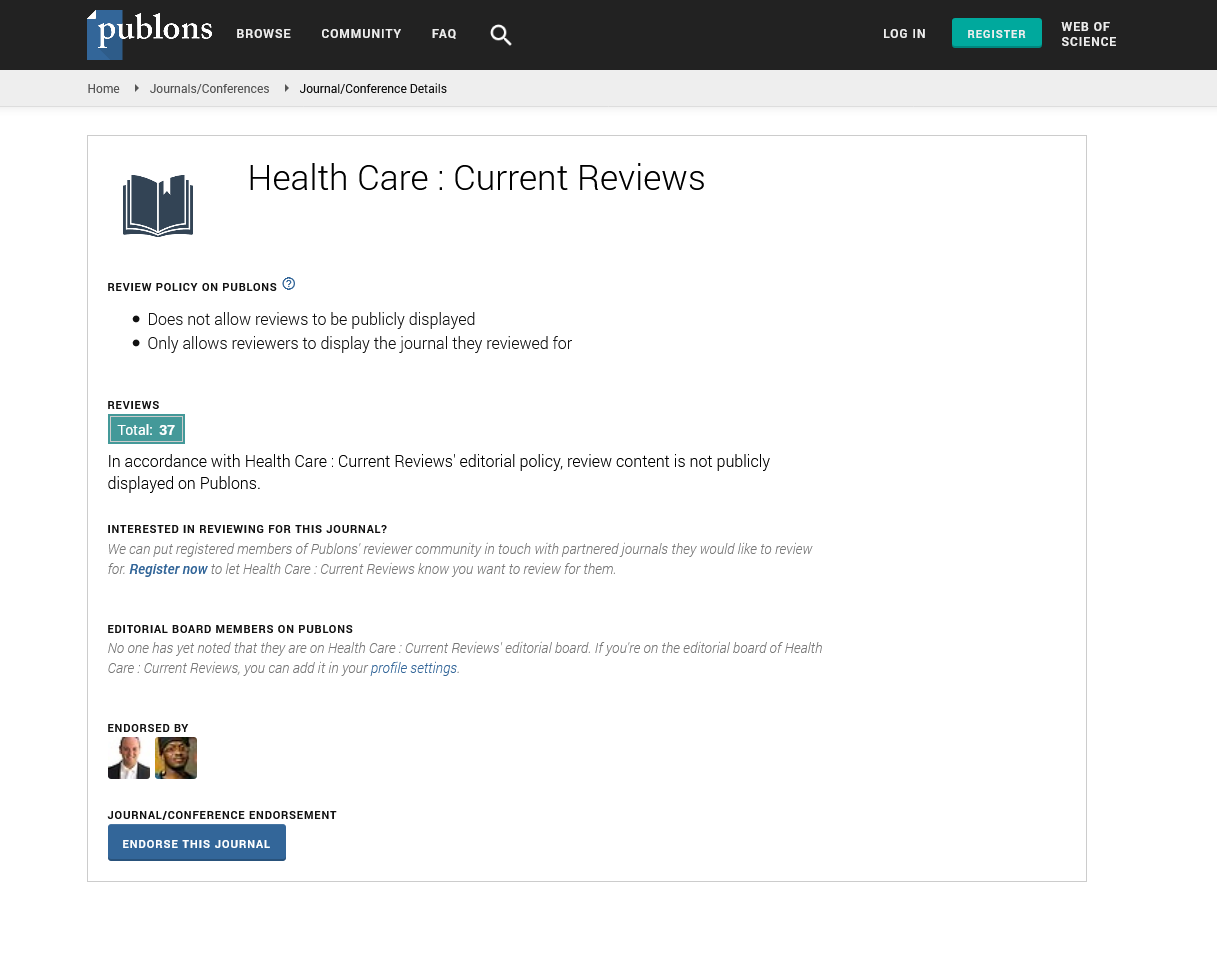Indexed In
- Open J Gate
- Academic Keys
- RefSeek
- Hamdard University
- EBSCO A-Z
- Publons
- Geneva Foundation for Medical Education and Research
- Google Scholar
Useful Links
Share This Page
Journal Flyer

Open Access Journals
- Agri and Aquaculture
- Biochemistry
- Bioinformatics & Systems Biology
- Business & Management
- Chemistry
- Clinical Sciences
- Engineering
- Food & Nutrition
- General Science
- Genetics & Molecular Biology
- Immunology & Microbiology
- Medical Sciences
- Neuroscience & Psychology
- Nursing & Health Care
- Pharmaceutical Sciences
Commentary - (2022) Volume 10, Issue 9
A Screening and Early Warning Health Management System for Populations at High Risk for Depression, Design and Preliminary Realization
Zhigeng Chen*Received: 02-Sep-2022, Manuscript No. HCCR-22-18364; Editor assigned: 05-Sep-2022, Pre QC No. HCCR-22-18364(PQ); Reviewed: 19-Sep-2022, QC No. HCCR-22-18364; Revised: 26-Sep-2022, Manuscript No. HCCR-22-18364(R); Published: 03-Oct-2022, DOI: 10.35248/2375-4273.22.10.312
Description
The level of depression is very high worldwide. According to traditional Chinese medicine's idea of disease prevention, timely detection and early warning signs of depression in populations at high risk can help prevent some of the dysfunctions brought on by the condition. This work investigated a technique for gathering data on depression, created a database of depression traits, designed algorithms for identifying populations at high risk for depression and building an early warning model, developed an early warning Short-Message Service (SMS) platform, and put a depression screening program and early warning health management system into practice. Depression is a persistent, chronic mental illness that has a serious negative impact on people's health [1]. The effects of depression, such as suicide and other grave outcomes, can be avoided through timely detection of groups at high risk for depression and focused interventions and therapies. Traditional Chinese medicine's idea of "preventive treatment of disease for populations at high risk for depression entails screening and early detection before the condition becomes too severe and then implementing the proper intervention procedures to prevent serious and catastrophic effects [2]. The development of public policies for the management of this condition is heavily influenced by research on mental diseases, especially depression. Studying the prevention and treatment of depression in high-risk groups is therefore extremely important. Seeking to provide early warning on the risk of disease is the key to a disease's preventive treatment. Therefore, the foundation and primary step for preventive therapy and management of depression is monitoring and early warning for groups at high risk for depression. The prevention of tragic events brought on by the worsening of depression and the quick restoration of mental health are made possible by early warning, early formation of a health intervention strategy and actual health interventions [3]. Consequently, the creation of a system for early detection and health management of depression in people at high risk Self-care and health monitoring were accomplished using mobile health apps. In order to identify ways to make these apps better, examined how customers utilize apps for health monitoring and the advantages that come with it. A user-cantered web version of a depression symptom health management system was created by in Korea [4]. It primarily offers depression-related knowledge and a self-assessment scale without utilizing the most advanced artificial intelligence technology. Symptoms and may even enhance mental health in the working population. Four strategies are used by the health data acquisition terminal mobile apps, smart watches, smartphones and cloud computing.
The information system for managing depression's health uses computer software. Continuous model training and optimization are required for the depression screening and early warning model. The cloud platform is used because as the system is used, fresh data are added. The cloud platform routinely offers the ability to download the most recent model. The key to the prevention and management of depression is the screening and early warning of a population at high risk for depression. A depression screening and early warning model can be created using the features of the retrieved modeling data and a machine learning technique. To successfully alter national health policies and enhance the efficiency of health care delivery organizations, health system reform and patient care education and practice must be tightly coordinated [5]. The necessity for incentive-based organizational performance is discussed in this research along with any implications for Health Care Management Education (HCME) and practice that are pertinent. Additionally, it describes the main justification for Value-Based Payment (VBP) or Pay for Performance (P4P) health policy initiatives as well as their fundamental components. It is obvious that the current big shift in global health policy will ultimately likely have a significant impact on the strategic and operational management and performance of health care delivery companies. Thus, adjustments that need to be made and enhanced in current health care management education and development are discussed in realistic, particular ways.
REFERENCES
- Bae J, Wolpin S, Kim E, Lee S, Yoon S, An K. Development of a user‐centered health information service system for depressive symptom management. Nurs Health Sci. 2009; 11(2):185-193.
[Crossref] [Google Scholar] [PubMed]
- BinDhim NF, Shaman AM, Trevena L, Basyouni MH, Pont LG, Alhawassi TM. Depression screening via a smartphone app: cross-country user characteristics and feasibility. J Am Med Inform Assoc. 2015; 22(1):29-34.
[Crossref] [Google Scholar] [PubMed]
- Gomez-de-Regil L, Avila-Nava A, Gutierrez-Solis AL, Lugo R. Mobile apps for the management of comorbid overweight/obesity and depression/anxiety: a systematic review. J Healthc Eng. 2020.
[Crossref] [Google Scholar] [PubMed]
- Shinohara S, Toda H, Nakamura M, Omiya Y, Higuchi M, Takano T, et al. Evaluation of the severity of major depression using a voice index for emotional arousal. Sensors. 2020; 20(18):5041.
[Crossref] [Google Scholar] [PubMed]
- Ding X, Yue X, Zheng R, Bi C, Li D, Yao G. Classifying major depression patients and healthy controls using EEG, eye tracking and galvanic skin response data. J Affect Disord. 2019; 251:156-161.
[Crossref] [Google Scholar] [PubMed]
Citation: Chen Z (2022) A Screening and Early Warning Health Management System for Populations at High Risk for Depression, Design and Preliminary Realization. Health Care Curr Rev. 10:312.
Copyright: © 2022 Chen Z. This is an open-access article distributed under the terms of the Creative Commons Attribution License, which permits unrestricted use, distribution, and reproduction in any medium, provided the original author and source are credited.

